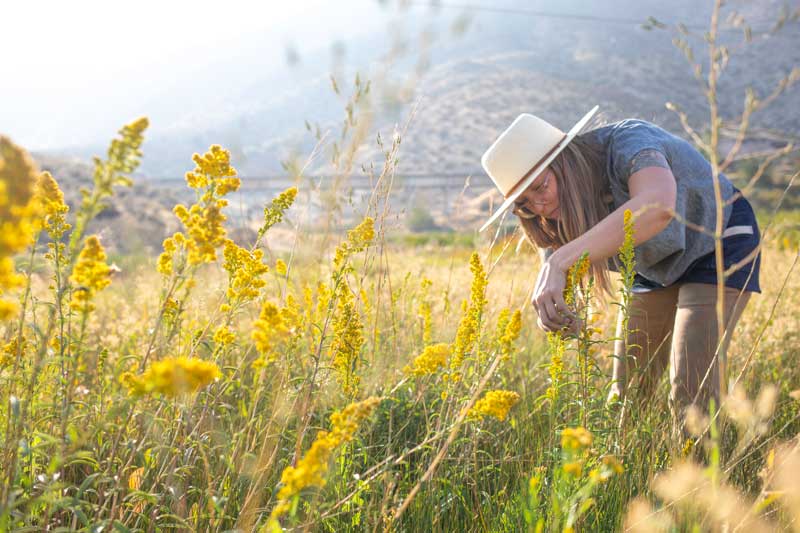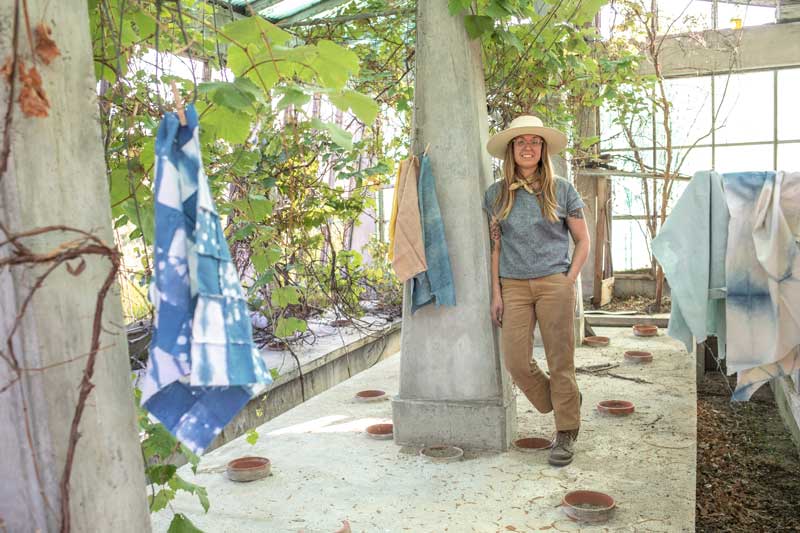Where farming, fabric, fashion, and fiber intersect sustainably.
A conscientious eater thinks deeply about his or her food and asks questions: Where was this produced? Did it come from my local foodshed? How was it produced? Were the animals treated humanely? Did the farm integrate sustainability measures into its processes? And the list continues.
Just as the slow food movement questions the procurement of what we eat, the slow cloth movement examines the creation of the materials woven into our daily lives.
“I think that’s a natural extension for people who are already thinking about where their food comes from,” says Sarah Lillegard, a renaissance woman and interdisciplinary artist whose experience in fabric ranges from shearing to dyeing and weaving. “Where does your fabric come from? What are you supporting with those purchases?”
Like the slow food movement, the slow cloth movement embraces teaching, community, diversity, and responsible sourcing and use of materials.
“The slow fashion movement and the slow food movement have many parallels,” says Lani Estill, rancher, fiber artist, and owner of Lani’s Lana in Reno. The fibers used in Estill’s yarn are sourced from the Bare Ranch in Surprise Valley, which supports a Rambouillet sheep operation in the high desert area of the Great Basin in Northwestern Nevada and Northeastern California.
The slow cloth movement begins on the farm, with materials finding their way through the hands of farmers, shearers, weavers, dyers, artisans, artists, and consumers. This creates opportunities for individuals to insert themselves at various points in the cycle, Lillegard says.
“It’s interesting with fiber because the process is so lengthy,” she says. “It depends on where a person wants to break it down, what component of the whole process is the most interesting for them.”

Fabrics dyed with locally sourced flowers, curly dock and goldenrod
She breaks down the production of fibers that come from animals into several steps, including farming and animal husbandry, shearing, textile creation (including yarnmaking, spinning, and weaving), dyeing, and the art or use of the items.
Lillegard’s introduction to textiles came with the Reno Fiber Guild, which was established in 1972 to promote and encourage growth in weaving, spinning, and related fiber techniques. For her, exploring the different stages of the fabric’s life cycle is essential to her art and experience.
“I’m such a dabbler,” she says. “I’m interested in what information is lent through the body experience, by using my labor as a lens to understand things.”

Lillegard inspects and harvests the goldenrod at the best moment for its color potency
Sheepish behavior
Lillegard is a certified shearer, trained in the New Zealand method of shearing through the University of California Cooperative Extension Mendocino County’s Sheep Shearing School. Through her operation, High Desert Shearing, she offers considerate, small-flock shearing of sheep and goats throughout Northern Nevada and Northeastern California.
“I’ve heard shearers say that someone who’s raising sheep in a different country would recognize the process of shearing, and for someone who had raised sheep 1,000 years ago, the shearing process in contemporary times would be familiar,” she says “So it’s this skill set that transcends location and time.”
On Estill’s farm, a similar timelessness exists. The sheep graze outside under the watchful eye of the sheepherders and their dogs.
“It is a lifestyle rooted in tradition and grandeur,” Estill’s website says, “close to the earth, close to nature, and ever so open and exposed to elements beyond the control of man.”
Estill’s Rambouillet wool is some of the first climate-beneficial wool grown in California, which is accomplished by working with rotational grazing, compost applications, creek restorations, and other land-management strategies such as no-till farming.
From farm to fabric, Estill and Lillegard encourage people to think about where their textiles come from and how their choices impact the environment.
“I think we do have to change people’s minds to where you buy less, but you buy quality,” Estill says. “If you buy one garment a year, pretty soon you’re going to have a sustainable wardrobe that you enjoy. You know where each piece came from.”
The idea of sustainability is central to some of the new expressions of artist Rachel Hayes, whose fabric pieces are on exhibit at the Nevada Museum of Art as part of In the Flow through January 2021.
Hayes, who works in silk, polyester, nylon, and tulle, began creating art from bags of clothes destined for a donation pile.
“It’s something I’ve been kind of dabbling with for a couple of years now,” Hayes says. “I think something interesting is happening with what I’m doing. It’s a new frontier, which is perfect to work on in these unprecedented times.”
Annie Flanzraich is a Reno-based writer and editor who now feels compelled to ask, “Where did this fabric come from?” Read more about her at Flanzwrites.com.
Resources
Sarah Lillegard
Sarahlillegard.com • Highdesertshearing.com • Thriveandthicken.com
Lani’s Lana
Lanislana.com • Instagram: @Lanislanawool
Rachel Hayes
Instagram: @Rachelbhayes • Rachelbhayes.com • Lowellryanprojects.com


